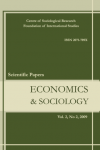THREE-DIMENSIONAL MODEL OF
FINANCIAL RESILIENCE IN
WORKERS: STRUCTURAL
EQUATION MODELING AND
BAYESIAN ANALYSIS
THREE-DIMENSIONAL MODEL OF
FINANCIAL RESILIENCE IN
WORKERS: STRUCTURAL
EQUATION MODELING AND
BAYESIAN ANALYSIS
Author(s): Miriam Flóres Bañuelos, Teresa Zamora-Lobato, Arturo García-SantillánSubject(s): National Economy, Health and medicine and law, Socio-Economic Research
Published by: Fundacja Centrum Badań Socjologicznych
Keywords: methodology SEM; financial resilience; financial well health indicators;
Summary/Abstract: This work focused on evaluating financialhealth indicators, namely their perception, experienceslived during the pandemic, and actions carried out to facethe financial crisis caused by the COVID-19. The eightfinancial health indicators proposed by BBVA bank andthe Center for Financial Services Innovation were usedfor the study. These make up a 24-item scale and are oftenused to measure perception, experiences during thepandemic, and financial resilience. The sample included357 workers from the Duxom Company, which hasnational coverage and operates in the private securitysector. The validity test showed an acceptable Cronbach'salpha index for each construct (α; 0.848; α; 0.779; α;0.818), denoting reliability and internal consistency. Thevalues obtained from asymmetry (<2) and kurtosis (<7)justified the normality of the data. The research findingssuggest that, while the perception of financial healthindicators has a very low influence on financial resilience(.05), the experiences lived during the pandemic inrelation to these indicators influenced (.74) the actionscarried out to face the financial crisis caused by theCOVID-19. The confirmatory model shows that the P-ISF construct is explained with 6 of the 8 variables; theEv-ISF construct – with 3 of 8, and the financial resilienceconstruct is explained with 7 of 8 variables(CMIN/DF:1.913; CFI:0.981; TLI: 0.973;RMSEA=0.05). The excluded variables show very lowestimates; therefore, it is recommended to expand futurestudies to other populations and samples.
Journal: Economics and Sociology
- Issue Year: 17/2024
- Issue No: 1
- Page Range: 69-88
- Page Count: 20
- Language: English

